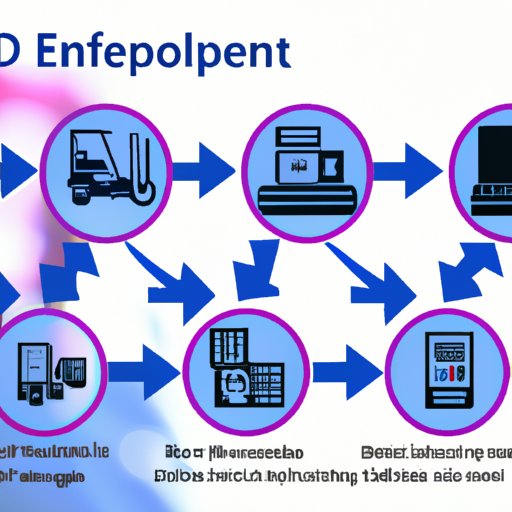Introduction
EDI stands for Electronic Data Interchange, and it is a key component of modern supply chain management. EDI is a system that allows businesses to exchange information electronically, such as purchase orders, invoices, shipping notices, and other documents. In today’s digital world, EDI is essential for streamlining the supply chain and enabling efficient communication between buyers and suppliers.

Overview of the Role of EDI in the Supply Chain
In the past, businesses relied on manual processes to manage their supply chains, which was both time-consuming and error-prone. With EDI, businesses can now automate many of these processes and improve the accuracy of their data. This helps them to save time and money, as well as reduce errors and delays. By leveraging EDI, businesses can create a more efficient and reliable supply chain.

How EDI Enhances Efficiency in the Supply Chain
To understand how EDI can help to streamline the supply chain, it is important to understand what EDI is and how it works. EDI is an electronic communication system that enables two or more parties to exchange data in a standardized format. This data is usually sent via email or FTP (File Transfer Protocol). Once the data is received, it can be processed and converted into a readable format, such as an Excel spreadsheet or database.
What is EDI and How Does it Streamline the Supply Chain?
EDI simplifies the process of exchanging data between businesses. It eliminates the need for manual data entry and reduces the risk of errors. Additionally, it can be used to automate transactions, such as purchase orders, invoices, and shipping notices. This means that businesses can quickly and easily communicate with their suppliers, customers, and other partners. This improves the overall efficiency of the supply chain and reduces the cost of doing business.
Benefits of Using EDI for Supply Chain Management
The use of EDI in supply chain management can offer numerous benefits, including:
- Improved accuracy – EDI eliminates the need for manual data entry, which reduces the risk of errors.
- Reduced costs – Automating the exchange of data can help to reduce the time and cost associated with manual processes.
- Faster processing times – EDI enables businesses to quickly and easily exchange data, which can lead to faster processing times.
- Increased visibility – EDI provides businesses with real-time access to data, which can help to improve visibility throughout the supply chain.

A Guide to Understanding EDI in the Supply Chain
Now that you know the basics of EDI in supply chain management, let’s take a closer look at how it can be used to streamline operations. Here are some of the advantages of implementing EDI:
- Improved data accuracy – By eliminating manual data entry, EDI can help to reduce errors and improve data accuracy.
- Faster transaction processing – Automating the exchange of data can help to speed up the processing of transactions.
- Enhanced visibility – EDI provides businesses with real-time access to data, which can help to improve visibility throughout the supply chain.
- Reduced costs – EDI can help to reduce the costs associated with manual processes.
In addition to these advantages, EDI can also help to reduce the risk of fraud. According to a recent study from the International Association for the Exchange of Business Data, “EDI provides an effective mechanism for reducing fraud risk by providing a secure, automated way to exchange documents.”
Common EDI Solutions for Supply Chain Management
There are a number of EDI solutions available for supply chain management. Some of the most popular solutions include:
- ERP systems – Enterprise resource planning (ERP) systems provide businesses with a comprehensive suite of tools for managing their supply chains. These systems typically include built-in EDI capabilities.
- EDI networks – EDI networks provide businesses with a secure, reliable way to exchange data. They typically require minimal setup and maintenance, making them ideal for small and mid-sized businesses.
- Cloud-based solutions – Cloud-based EDI solutions provide businesses with a cost-effective way to exchange data. These solutions are typically easy to set up and maintain, and they can be accessed from any location.
Conclusion
As you can see, EDI is a powerful tool for streamlining the supply chain. It can help to reduce the costs associated with manual processes and improve the accuracy of data. Additionally, it can provide businesses with real-time access to data, which can help to improve visibility throughout the supply chain. By leveraging EDI, businesses can create a more efficient and reliable supply chain.
(Note: Is this article not meeting your expectations? Do you have knowledge or insights to share? Unlock new opportunities and expand your reach by joining our authors team. Click Registration to join us and share your expertise with our readers.)
